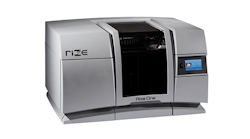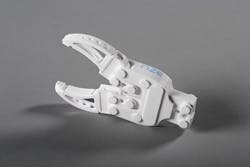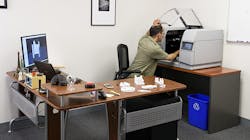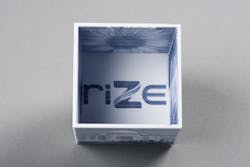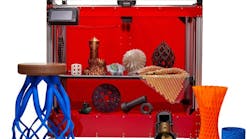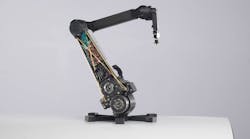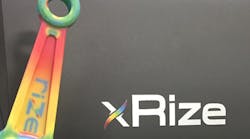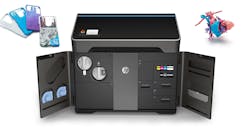In 2014, the biggest brains in 3D printing, from the inventor of 3D CAD software to the developer of inkjet 3D printing, stealthily joined forces to create a company whose goal was to break industrial 3D printers out of the lab and make them safe and easy enough to use in an office.
This week, the Boston startup Rize Inc.—the additive manufacturing dream team—has emerged from the shadows to unveil its new desktop industrial printer, the Rize One (starting at $19,000).
It eliminates nearly every pet peeve you’ve ever had about industrial 3D printing. Post-processing time? Gone. Weak material? Not anymore. Complex software? Simplified.
The 21 x 36 x 25 in. (533 x 914 x 635 mm) printer uses a patented Augmented Polymer Deposition process and game-changing material, Rizium One, that have been shown to cut overall turnaround time by 50%.
We asked Frank Marangell, President and CEO of Rize and former president of Objet North America, to tell us why this is finally the 3D printer you’ve been waiting for.
NED: How did the team get together?
Frank Marangell: CTO and founder Eugene Giller, who developed the material for Google Glass came up with the idea to solve the limitations in 3D printers and thought there has to be a better way. He tested his patented material, which has a mechanical strength that is 2x that of materials used on FDM systems, enough to convince many of us it was a good idea. He connected with Leonid Raiz, the architect of Pro/Engineer 3DCAD software.
They were looking for a CEO, and I just left Stratasys after the merger. I said, “Sign me up!” I knew this thing was going to be significant in the industry.
After an Investor presentation, we got funded in late 2014 (by Longworth Venture Partners and SB Capital with $4M in seed funding.)
NED: Why is this going to be so significant?
FM: It’s an industrial printer, with a build area of 12 x 8 x 6 in. (300 x 200 x 150 mm), made to run 24/7 that competes with larger $100,000 printers. The print takes the same time, but the post-processing can take mere seconds. Our patented technology and materials allow us to change the mechanical properties of the thermoplastic, voxel by voxel (3D pixel). That gives us the ability to jet a release layer, normally at 300 dpi, that separates the support from the model. The support material would normally lock to it, but because of our secondary process, which puts down a layer of Release One material between the support and layer above so it can’t attach to it, we’re able to pop off the support material without any post-processing, without any marks, filing or sanding.
NED: How much time does post-processing really consume though?
FM: One of our beta customers, Reebok, which makes everything from shoelaces to lacrosse heads, found that by eliminating post-processing, you could save on average of 50% on production time. That’s if you’re working 24/7. It could be you’re missing a shift because of post-processing and that costs you 24 hours.
We have that example ourselves. With print jobs that could take 6 to 8 hours, we’d print overnight using another technology prior to our printer being ready to use and want to use it right away the next day, but it needs 8 hours in a soluble support tank. If we’re not careful we could miss the day’s shift for use later that night and have to wait until the next morning.
Our technology saves that entire day of work and makes production-quality parts.
Reebok told us the lack of labor in post-processing labor could pay for this in less than a year. That doesn’t even include the time to get the designs out earlier and the post-processing materials needed with other systems. Better design integration is very hard to put a dollar amount on, but everybody’s striving for it.
NED: What other features stand out for users?
FM: We have from a filament standpoint, spots for two cartridges. Each has a tool at the end and the spool just plugs right in and is automatically fed into the machine. When the first one empties, it swaps over to the next cartridge automatically. It was one of my requirements. It has always been a pet peeve of mine that you don’t know if you have enough material to complete the build. You get 3/4 of the way through a build and run out.
NED: Short of giving us the recipe, what can you tell us about your patented material, Rizium One?
FM: The thermoplastic strength in the Z-axis creates a bond that is almost equal to the X and Y. The recipe gives us something above 60 megapascals in X, Y, and Z in strength. And it has high Heat Deflection Temperature (HDT) strength. It’s comparable to polycarbonate.
Compared to 3D Systems SLA or Stratasys’ ABSplus, it’s less than half the price. Those are about $260/kg; we’re going to be less than $100/kg.
And it’s made of eco-friendly material. It doesn’t give off any volatiles when extruding. ABS gives off styrene, PLA gives off lactide. It’s safer than what’s on 2D printers today. It makes the Rize One the first non-toxic 3D printer that is safe for the office environment.
NED: When will Rize One be available?
FM: We have beta machines ready. We’re going to start at Reebok and move on from there with other well-known names a couple hours drive from our office. It’s more of an early adopter system than a true beta. We’re taking orders in Q4, and they’ll get them in Q1. The machine is self-installed and is designed to run and run and run and does not need a service package. A service package will be available, though.
The first release will be grey-scale, but it has the ability to print in full color, which will be available in the next upgrade. The carriage to hold the heads is already in place. Then you can get into spare parts replacement.
NED: What industries will benefit most?
FM: The sky’s the limit where you can use it. Most 3D printers are known for form and fit, but not function. With ours, because of the Z strength, you’re able to get the function. You can produce a handlebar on a bicycle, any mechanical gear structure, and all mechanical parts.
An auto mechanic could produce custom parts on demand without worrying about the complexity of software or the post-processing nightmare. A doctor’s office can model CAT scan data, or surgical tools to explain the surgery to patients or to help with procedures. These are made today but made in labs far away from the user.
Rize Inc. has permanently shut down operations as of March 2022. Current customers can contact Palitra for equipment and material support.










